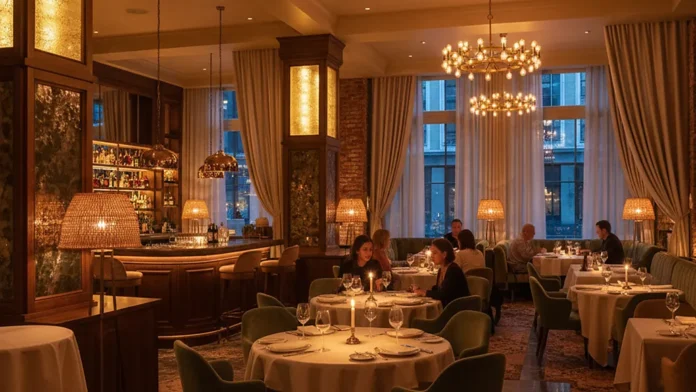Lighting as a Tool for Emotional and Experiential Design
The strategic use of illumination to create specific emotional responses and immersive environments represents one of the most sophisticated applications in contemporary architecture. Emotional lighting experiential design transcends basic functional requirements to engage human psychology, influence behavior, and create memorable experiences that resonate with occupants and visitors on deep psychological and emotional levels.
Understanding Light’s Psychological Impact on Human Experience
Light fundamentally affects human psychology through mechanisms that operate both consciously and unconsciously, influencing mood, energy levels, spatial perception, and emotional responses in ways that can dramatically alter how individuals experience architectural spaces. These psychological responses to lighting stem from evolutionary adaptations and learned associations that connect specific lighting characteristics with emotional states and behavioral patterns.
Color temperature variations significantly impact psychological responses, with warm lighting typically associated with comfort, relaxation, and intimacy, while cooler lighting tends to promote alertness, focus, and activity. Understanding these associations enables designers to craft lighting environments that support intended emotional responses while creating spaces that feel appropriate for their intended use patterns and occupant activities.
The intensity and distribution of light within spaces affects spatial perception and psychological comfort, with higher illumination levels generally promoting more active, social behaviors, while lower lighting levels tend to encourage contemplation, intimacy, and introspective activities. Strategic manipulation of these lighting characteristics enables designers to influence how people interact with spaces and each other.
Creating Atmospheric Narratives Through Illumination
Contemporary emotional lighting experiential design approaches treat illumination as a storytelling medium that can communicate narratives, establish temporal relationships, and create immersive environments that transport occupants beyond immediate physical reality. These narrative lighting approaches transform spaces into experiential destinations rather than merely functional environments.
Dynamic lighting sequences can create temporal experiences that unfold over time, guiding occupants through emotional journeys that enhance their connection to spaces while creating memorable experiences that extend beyond simple architectural appreciation. These time-based lighting experiences require sophisticated control systems and careful choreography to achieve intended emotional impact.
The layering of different lighting elements at various scales creates visual complexity and depth that supports rich experiential environments. Ambient lighting establishes overall mood, accent lighting highlights specific features and creates focal points, while decorative lighting adds personality and character that contributes to overall atmospheric quality and emotional impact.
Biophilic Lighting and Natural Pattern Integration
Biophilic design principles recognize that humans possess innate connections to natural systems and patterns that can be supported and enhanced through thoughtful lighting design that mimics natural phenomena. These approaches create emotional connections to nature even within completely artificial environments, supporting psychological wellbeing and environmental satisfaction.
Circadian lighting systems that replicate natural daylight patterns throughout interior spaces help maintain biological connections to natural cycles while creating environments that feel alive and responsive rather than static and artificial. These systems support both physiological health and psychological comfort through lighting that changes gradually throughout daily cycles.
The integration of natural materials, textures, and forms in lighting design creates tactile and visual connections to natural systems while supporting biophilic responses that enhance emotional comfort and environmental satisfaction. Wood, stone, water, and plant elements in lighting installations create multi-sensory experiences that engage occupants on multiple levels.
Cultural Context and Symbolic Meaning in Lighting Design
Lighting design must consider cultural associations and symbolic meanings that vary between different communities and user groups, requiring sensitivity to local traditions, religious considerations, and social expectations that influence how lighting is perceived and interpreted by intended audiences.
Color symbolism varies significantly between different cultures and contexts, with specific colors carrying different emotional associations and social meanings that affect how lighting installations are received and interpreted. Understanding these cultural dimensions enables more appropriate and effective emotional lighting design that resonates positively with intended occupants.
Historical references and traditional lighting approaches can create emotional connections to cultural heritage while supporting contemporary functional requirements. The integration of traditional elements with modern technology enables lighting designs that honor cultural traditions while providing current performance capabilities and operational efficiency.
Hospitality and Retail Experience Design
Commercial applications of emotional lighting experiential design demonstrate sophisticated approaches to customer engagement and brand communication through carefully crafted lighting environments that support business objectives while creating memorable experiences that encourage customer loyalty and satisfaction.
Restaurant and hotel lighting design creates intimate, welcoming environments that encourage longer stays and positive associations while supporting various activities throughout different times of day. These installations must balance functional requirements with atmospheric objectives while maintaining consistent quality throughout varying occupancy and activity levels.
Retail lighting strategies guide customer movement through spaces while highlighting merchandise and creating emotional connections to brands and products. These lighting approaches must support both practical shopping activities and experiential engagement that enhances customer satisfaction and encourages return visits.
Healthcare and Therapeutic Environment Applications
Healthcare environments present unique opportunities for emotional lighting experiential design applications where lighting quality directly impacts patient outcomes, family experiences, and staff performance during often stressful and emotionally challenging situations.
Patient room lighting must support medical procedures while creating healing environments that promote recovery and psychological comfort. The ability to adjust lighting conditions for different activities and times of day helps create spaces that feel more residential and less institutional while maintaining clinical functionality.
Therapeutic lighting applications including light therapy for Seasonal Affective Disorder and circadian rhythm regulation demonstrate direct medical applications of lighting design that support specific health outcomes while creating environments that feel supportive rather than clinical.
Entertainment and Cultural Venue Design
Performance venues and cultural institutions showcase sophisticated applications of emotional lighting experiential design where illumination serves both practical and artistic functions while supporting diverse programming requirements and audience experiences.
Theater and concert hall lighting must support performance requirements while creating audience environments that enhance focus and emotional engagement with performances. These systems require exceptional flexibility and precise control capabilities that enable rapid changes while maintaining appropriate audience comfort throughout events.
Museum and gallery lighting creates viewing environments that enhance artwork appreciation while supporting conservation requirements and visitor comfort throughout extended viewing periods. These installations must balance preservation needs with experiential quality while accommodating diverse exhibition requirements.
Residential and Personal Space Applications
Residential emotional lighting experiential design focuses on creating environments that reflect personal preferences while supporting daily life patterns and family activities. These applications require particular attention to individual needs and lifestyle variations that affect lighting preferences and usage patterns.
Living space lighting must accommodate diverse activities throughout the day while creating environments that feel welcoming, comfortable, and personally meaningful. The integration of multiple lighting layers and control options enables residents to customize lighting conditions while maintaining overall design coherence.
Bedroom and personal space lighting requires special consideration for its role in supporting rest and relaxation while providing functional illumination for various activities. These installations must balance circadian support with personal preferences while maintaining flexibility for individual needs and changing requirements.
Technology Integration and Interactive Lighting
Advanced control systems and interactive technologies enable responsive lighting environments that adapt to occupant presence, activities, and preferences while creating dynamic experiences that engage users as active participants rather than passive recipients of predetermined lighting conditions.
Motion-activated and presence-sensing lighting systems create responsive environments that acknowledge and welcome occupants while optimizing energy consumption through intelligent operation that provides illumination when and where needed without requiring conscious user intervention.
Voice control and mobile app interfaces enable intuitive interaction with sophisticated lighting systems while providing access to complex functionality through user-friendly interfaces that accommodate varying levels of technical expertise and personal preference for control methods.
Seasonal and Temporal Experience Design
Lighting installations that acknowledge and celebrate seasonal changes create temporal connections that help occupants maintain awareness of natural cycles while creating environments that feel alive and responsive rather than static and disconnected from outdoor conditions.
Holiday and celebration lighting transforms spaces for special occasions while creating emotional associations with positive experiences that enhance occupant satisfaction and create lasting memories connected to specific places and environments.
Event-specific lighting programming enables spaces to transform for different functions while maintaining base-level functionality and design quality. These capabilities support diverse programming requirements while providing operational flexibility that extends building usefulness and user satisfaction.
Measuring Success and User Response
Evaluating the effectiveness of emotional lighting experiential design requires consideration of both quantitative metrics and qualitative user responses that capture the subjective experiences and emotional impacts that define project success beyond basic technical performance criteria.
Post-occupancy surveys and user feedback collection provide insights into how lighting installations affect occupant satisfaction, behavioral patterns, and emotional responses while identifying opportunities for optimization that can enhance performance over time.
Behavioral observation and usage pattern analysis help verify whether lighting installations achieve intended effects on occupant behavior and space utilization while providing data that supports ongoing optimization efforts and informs future design decision-making.
The application of lighting as a tool for emotional and experiential design continues to evolve as technology advances and our understanding of human psychology and environmental perception deepens. The most successful implementations balance artistic vision with psychological insight while maintaining attention to practical considerations that ensure long-term performance and user satisfaction throughout building lifecycle.































